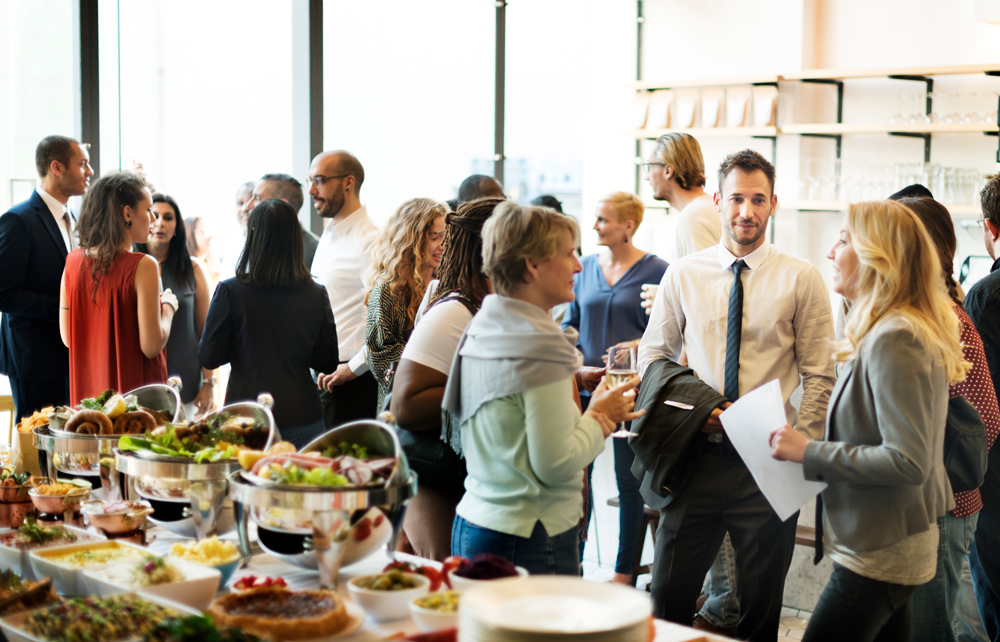

For Restaurants
Q2 Update: Business Meetings & Events Outlook
As in-person meetings continue their revival, here’s how restaurants can capitalize.
During the pandemic, it wasn’t just corporate remote workers longing for fewer hours spent in Zoom meetings. As business meetups and events went virtual, restaurants (and their bottom lines) also felt the effects. COVID lockdowns and remote work brought business dining, catering, and private events to a temporary halt and could permanently change how companies conduct business in the longer term.
Still, our Q1 State of Business Dining Report predicted a more promising outlook for restaurants as business dining behavior showed signs of reaching a “new normal.” One of the main drivers? The return of in-person meetings and events. Although average office occupancy still hovered around 50%, according to Kastle’s “Back to Work Barometer,” meetings activity outperformed forecasts. Event planning professionals reported larger budgets as pent-up demand for face-to-face connections caused businesses to pull out all the stops.
As we approach the second half of the year, have those trends and predictions held? Let’s look at the latest information.
The current state of hybrid & remote work
Many wondered if businesses would gain the upper hand as the economy slowed, expediting the return to in-person work. Yet, Kastle’s average office occupancy rate remains around 50%. It’s important to note that the number is an average of the five weekdays, and there is significant variation between weekdays. Fridays had an average of 34% as of this writing, dragging down weekly office attendance numbers. Tuesdays, on the other hand, had the highest average occupancy: 58.4%.
The Kastle number also averages ten major U.S. markets, with major differences between regions. In Austin, for example, average office occupancy is over 60%; in San Jose, it’s just under 40%. It underscores the importance of understanding the nuances in individual communities and adapting along with them, rather than awaiting a nationwide “return to office” movement that has not come to fruition.
How have business meetings & events fared in 2023?
It’s still safe to say in-person meetings are seeing a revival. In April, Knowland reported a nearly 80% increase in event volume between March 2022 and March 2023. Q1 2023 recovery outperformed the original Knowland forecast by 12.5%, and 23 of the 25 markets studied are expected to achieve 100% or greater recovery by 2024.
Not only that, but business people report yearning for deeper, more engaging human connections during these meetings. While strengthening culture and relationships has always been a main driver of corporate travel and events, maximizing face time is now a top objective for travel and event planners. Business people are intentionally planning their travel schedules and destinations around these networking opportunities.
What could be more conducive to building connections and culture than shared meals? This growing sentiment, plus the resurgence of in-person meetings across the country, should have restaurants everywhere seeing dollar signs.
Capitalizing on the growing meetings & events market
To earn corporate business from increased meetings and events, restaurants should understand the evolving preferences of business travelers. Here are a few trends to keep in mind.
- For many, technology is table stakes. Does your restaurant have tools to help companies find you, quickly book reservations and private spaces, and enjoy a seamless experience from booking to paying the check? Decision makers increasingly expect these conveniences.
- Environmental policies increasingly impact decision-making. Companies will seek sustainable vendors, including restaurants, to help them meet their environmental goals. Many business diners prefer eco- and socially-conscious restaurants, too, so promote your restaurant’s initiatives.
- Corporate event planners have unique requirements. About half of corporate event planners find and book venues online, and they have specific requirements that can differ from other types of events. Does your restaurant offer customizable event spaces, AV capabilities, power charging stations, and more? Make sure your private dining spaces, menus, packages, and amenities are listed on your website and easy to find. Better yet: provide images and floor plans, and set up email templates to help you quickly respond to inquiries. Event planners are notoriously busy
Services like Dinova’s Dine Assist can help connect corporate event planners to restaurants that meet their unique needs. Developed to help corporate partners quickly source high-quality restaurant venues that suit their budget, date, and other requirements, it’s a great option for restaurants to get in front of event planners and generate valuable repeat business.
Q1 | 2023
State of Business Dining Report
Want more exclusive business dining insights? Download our free State of Business Dining Report
